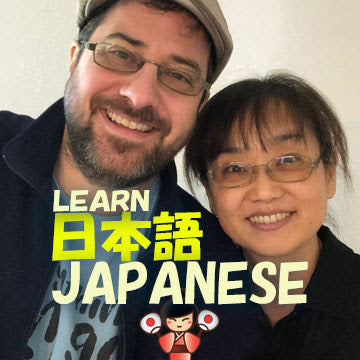

Kana de Manga Special Edition: Japanese Sound FX!
$ 9.99
Paperback. 112 pages. 7 x 5 inches.
-----------------
Have you ever wondered what a cat's meow sounds like in Japanese? How about the grumble of an empty stomach, the vroom of an automobile or the crash of an ocean wave?
Japanese Manga artists rely heavily upon onomatopoeia — sound-effects words — and this special entry in the best-selling Kana de manga and kanji de manga language-learning series from Manga University is jam-packed with nearly 200 illustrated examples of Japanese sound effects (and their English translations) in action!
Written by Glenn Kardy, editor of several volumes in the popular How to Draw Manga series, including Getting Started, the first book of its kind to be used at major universities in the United States (UCLA) and Japan (Waseda). Artwork by Chihiro Hattori. Features a foreword by Ronald A. Morse, retired professor of Japan Studies at UCLA and the University of Nevada, Las Vegas.


Japanese Vocabulary for JLPT N5 -- Master the Japanese Language Proficiency Test N5 [Paperback]
$ 14.99
SAVE WITH DIGITAL! This item is included in a digital bundle at a discount. If you would like the eBook version (PDF, ePub, or Kindle MOBI) and the MP3s, please see our discounted bundles here - JLPT N5 BUNDLE
Included at no extra charge are 1,445 MP3s of each Vocabulary and Example Sentence. The download link is found on the last page. Japanese Vocabulary for JLPT N5 covers all the vocabulary needed to pass the Japanese Language Proficiency Test level N5. This is the easiest of the test levels and is suitable for beginners who have mastered hiragana.
BEGINNER LEVEL
Over 1,400 MP3s
MP3s both with individual vocabulary words and example sentences
Bonus Chapter MP3s listening in order
Chapter MP3s include the vocabulary word, each example sentence, and then the English translation [Designed to be listened to with or without the eBook]
Includes PDF, ePub, and MOBI Kindle eBook formats
Each kanji has furigana (small hiragana over the kanji)
Add the 1,445 MP3s to your MP3 player, iPhone, or computer and listen while studying the book. Five large MP3 files are also included. These have each word followed by the example sentence for sequential learning.


Kanji De Manga Volume 4: The Comic Book That Teaches You How To Read And Write Japanese! (v. 4)
$ 9.99
Paperback. 144 pages. 7 x 5 inches.
-----------------
Our award-winning series moves forward with an all-new selection of 80 kanji geared toward intermediate learners of the language. Upon completion of this and the previous three volumes, students will have learned a total of 320 kanji, enough to prepare them for the advanced levels of the official Japanese Language Proficiency Test.
"A brilliant idea!" says Ronald A. Morse, retired professor of Japan Studies at UCLA and the University of Las Vegas, Nevada. "Japanese kanji — the written symbols adapted from Chinese — were originally drawings of images from real life. Japanese comic books and cartoons now provide fresh images to help us learn. Kanji de Manga uses today's manga images to make the kanji learning process fun and easy for otaku of all ages. This is a brilliant approach to learning the language."
Each page features its own comic strip, kanji pronunciation guide, stroke order, and English explanations.
Created by Glenn Kardy, editor of several volumes in the popular How to Draw Manga series, including Getting Started, the first book of its kind to be used at major universities in the United States (UCLA) and Japan (Waseda). Artwork by Chihiro Hattori, niece of legendary manga artist Eichi Fukui.
![Sound Words in Japanese [Instant Digital Download] - The Japan Shop](http://www.thejapanshop.com/cdn/shop/products/sound-cover_816d9006-ac3b-4aa9-9a3a-951e01895b6e_375x.jpg?v=1581115757)
![Sound Words in Japanese [Instant Digital Download] - The Japan Shop](http://www.thejapanshop.com/cdn/shop/products/sound1_375x.png?v=1580913536)
Sound Words in Japanese [Paperback]
$ 14.99
This is for the paperback version which will be mailed to you. It includes the digital files, but if you prefer digital only, check out our money-saving Vocabulary Booster Bundle here.
Sound Words in Japanese
99 Essential Sound and Action Words in Japanese
Struggling to sound natural in Japanese? Looking for a Japanese "text"book that's as fun as it is educational? Learn how to use ninety-nine essential Japanese onomatopoeic sound words.
Japanese uses these fun sound words more often than we do in English. This book covers ninety-nine of the most useful sound words. In addition, each word also has an example sentence to show context.
Each of the ninety-nine entries begins with the target word itself and several English definitions. A single example sentence showing usage follows. At the bottom of the page are some notes either about the word itself or the example sentence.
Each word has its own MP3. The sound file is named for the word itself. The MP3 has the word and example sentence in Japanese.
* Furigana (small hiragana over each kanji)
* Completely new recordings of all Japanese
* Corrected mistakes and expanded with new words
* Added comments for every single sound word


Learn Japanese through Dialogues Volume 3: At the Restaurant [Paperback]
$ 14.99
SAVE WITH DIGITAL! Don't need a physical book? This is also available in this Money-Saving Digital Bundle.
134 Pages | Includes Digital Files | 5.5 x 8.5 inch Paperback
Note: this is a physical paperback that will be shipped to you. You'll also receive the digital files by email immediately after ordering.
Finally, a fun and easy way to learn REAL conversational Japanese! (And get FREE MP3s of all the dialogues too!)
Learn Japanese vocabulary in context, improve your listening comprehension, and learn how to talk to others in Japanese.
This was written for beginners of Japanese, but if you haven't yet learned hiragana, please see our Beri- Beri- Shoshinsha here.
We are including, at no extra charge, MP3s for the seven dialogues found in this book. Create play-lists to study on the go or burn the sound files to a CD to listen at home. The download link will be emailed to you immediately after ordering. The MP3s are all recorded by native voice actors and actresses.
The dialogues found in this book are all about context and how Japanese is actually used with friends casually and when peppered with politeness among new acquaintances.
Please use the sound files (included in this download). We hope this book by itself will be helpful, but the sound files--in our opinion--give it most of its value.
Contents:Dialogue 1: Making ReservationsDialogue 2: Getting a Table for a FriendDialogue 3: Meeting Sally LateDialogue 4: OrderingDialogue 5: Waiting for FoodDialogue 6: UdonDialogue 7: New Year and SobaDialogue 8: At a Donut Shop
What are you waiting for? Ninja up your Japanese. Click “Add to Cart” now!
Please note: This is a physical paperback which will be shipped to you. You'll also receive a download link for the digital files immediately after ordering. Please check your spam folder if you don't see it.


Kana de Manga
$ 9.99
Paperback. 144 pages. 7 x 5 inches.
-------------------
Great for beginners!
American pop culture is turning Japanese. Every day, millions of kids spend hours watching translated anime on Cartoon Network and reading telephone book-sized comics called manga. From Spirited Away to Shonen Jump, if the label says "Made in Japan," it's cool.
But what if you want to enjoy anime and manga in its original language? Written Japanese consists of three scripts: the phonetic hiragana and katakana syllabaries, each comprised of 46 characters (collectively known as kana); and kanji, a complex set of characters based on Chinese ideographs. Hiragana and katakana are the true "ABCs of Japanese," as they can be used to write complete sentences. Children in Japan learn to read and write hiragana and katakana long before they are introduced to kanji. Most manga targeted toward the youngest readers in Japan are also written completely in kana.
Kana de Manga makes learning hiragana and katakana easy and fun for students who already enjoy Japanese comics. Each page has a humorous manga illustration representing a word that begins with the hiragana or katakana character featured prominently at the top. A brief explanation accompanies each drawing; the English equivalent of the word is given, and there is a work area where students can practice writing the characters.
Written by Glenn Kardy, editor of several volumes in the popular How to Draw Manga series, including Getting Started, the first book of its kind to be used at major universities in the United States (UCLA) and Japan (Waseda). Artwork by Chihiro Hattori. Features a foreword by Ronald A. Morse, retired professor of Japan Studies at UCLA and the University of Nevada, Las Vegas.

